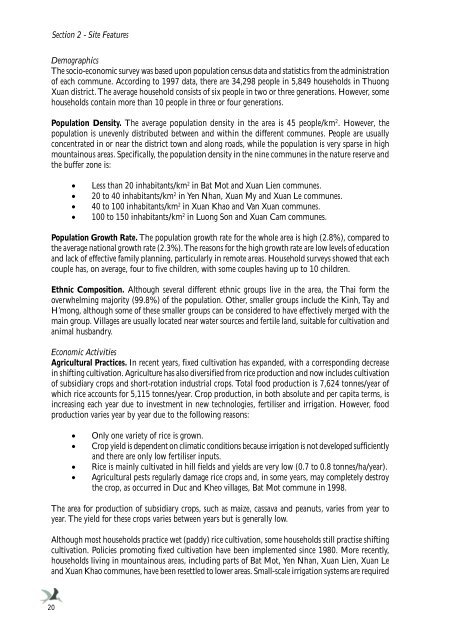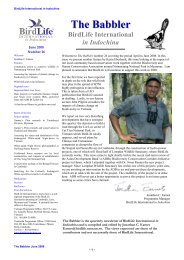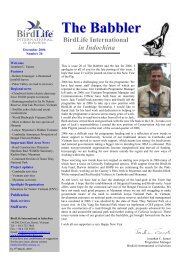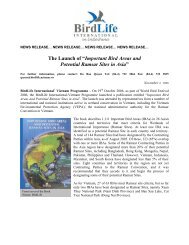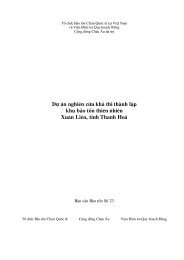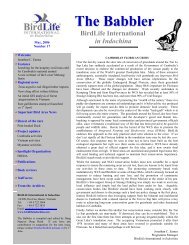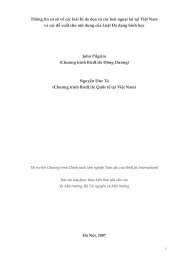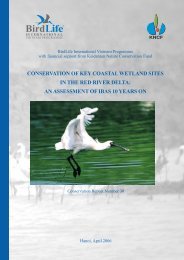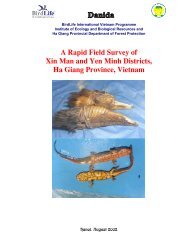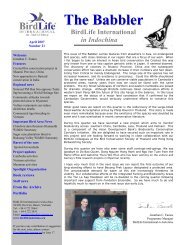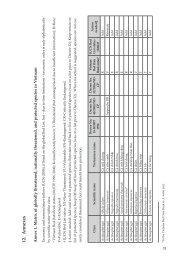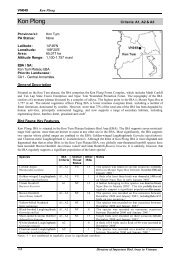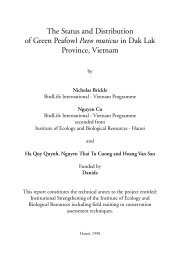A Feasibility Study for the Establishment of Xuan Lien Nature ...
A Feasibility Study for the Establishment of Xuan Lien Nature ...
A Feasibility Study for the Establishment of Xuan Lien Nature ...
You also want an ePaper? Increase the reach of your titles
YUMPU automatically turns print PDFs into web optimized ePapers that Google loves.
Section 2 - Site Features<br />
Demographics<br />
The socio-economic survey was based upon population census data and statistics from <strong>the</strong> administration<br />
<strong>of</strong> each commune. According to 1997 data, <strong>the</strong>re are 34,298 people in 5,849 households in Thuong<br />
<strong>Xuan</strong> district. The average household consists <strong>of</strong> six people in two or three generations. However, some<br />
households contain more than 10 people in three or four generations.<br />
Population Density. The average population density in <strong>the</strong> area is 45 people/km 2 . However, <strong>the</strong><br />
population is unevenly distributed between and within <strong>the</strong> different communes. People are usually<br />
concentrated in or near <strong>the</strong> district town and along roads, while <strong>the</strong> population is very sparse in high<br />
mountainous areas. Specifically, <strong>the</strong> population density in <strong>the</strong> nine communes in <strong>the</strong> nature reserve and<br />
<strong>the</strong> buffer zone is:<br />
20<br />
• Less than 20 inhabitants/km 2 in Bat Mot and <strong>Xuan</strong> <strong>Lien</strong> communes.<br />
• 20 to 40 inhabitants/km 2 in Yen Nhan, <strong>Xuan</strong> My and <strong>Xuan</strong> Le communes.<br />
• 40 to 100 inhabitants/km 2 in <strong>Xuan</strong> Khao and Van <strong>Xuan</strong> communes.<br />
• 100 to 150 inhabitants/km 2 in Luong Son and <strong>Xuan</strong> Cam communes.<br />
Population Growth Rate. The population growth rate <strong>for</strong> <strong>the</strong> whole area is high (2.8%), compared to<br />
<strong>the</strong> average national growth rate (2.3%). The reasons <strong>for</strong> <strong>the</strong> high growth rate are low levels <strong>of</strong> education<br />
and lack <strong>of</strong> effective family planning, particularly in remote areas. Household surveys showed that each<br />
couple has, on average, four to five children, with some couples having up to 10 children.<br />
Ethnic Composition. Although several different ethnic groups live in <strong>the</strong> area, <strong>the</strong> Thai <strong>for</strong>m <strong>the</strong><br />
overwhelming majority (99.8%) <strong>of</strong> <strong>the</strong> population. O<strong>the</strong>r, smaller groups include <strong>the</strong> Kinh, Tay and<br />
H’mong, although some <strong>of</strong> <strong>the</strong>se smaller groups can be considered to have effectively merged with <strong>the</strong><br />
main group. Villages are usually located near water sources and fertile land, suitable <strong>for</strong> cultivation and<br />
animal husbandry.<br />
Economic Activities<br />
Agricultural Practices. In recent years, fixed cultivation has expanded, with a corresponding decrease<br />
in shifting cultivation. Agriculture has also diversified from rice production and now includes cultivation<br />
<strong>of</strong> subsidiary crops and short-rotation industrial crops. Total food production is 7,624 tonnes/year <strong>of</strong><br />
which rice accounts <strong>for</strong> 5,115 tonnes/year. Crop production, in both absolute and per capita terms, is<br />
increasing each year due to investment in new technologies, fertiliser and irrigation. However, food<br />
production varies year by year due to <strong>the</strong> following reasons:<br />
• Only one variety <strong>of</strong> rice is grown.<br />
• Crop yield is dependent on climatic conditions because irrigation is not developed sufficiently<br />
and <strong>the</strong>re are only low fertiliser inputs.<br />
• Rice is mainly cultivated in hill fields and yields are very low (0.7 to 0.8 tonnes/ha/year).<br />
• Agricultural pests regularly damage rice crops and, in some years, may completely destroy<br />
<strong>the</strong> crop, as occurred in Duc and Kheo villages, Bat Mot commune in 1998.<br />
The area <strong>for</strong> production <strong>of</strong> subsidiary crops, such as maize, cassava and peanuts, varies from year to<br />
year. The yield <strong>for</strong> <strong>the</strong>se crops varies between years but is generally low.<br />
Although most households practice wet (paddy) rice cultivation, some households still practise shifting<br />
cultivation. Policies promoting fixed cultivation have been implemented since 1980. More recently,<br />
households living in mountainous areas, including parts <strong>of</strong> Bat Mot, Yen Nhan, <strong>Xuan</strong> <strong>Lien</strong>, <strong>Xuan</strong> Le<br />
and <strong>Xuan</strong> Khao communes, have been resettled to lower areas. Small-scale irrigation systems are required


